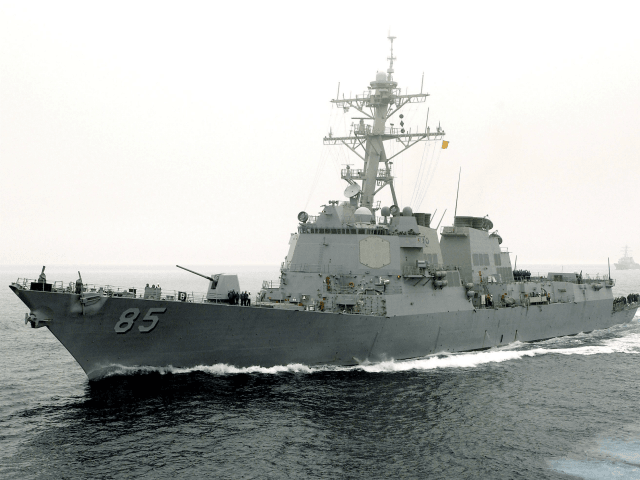Two U.S. warships passed through the Taiwan Strait on Thursday in a Freedom of Navigation Operation (FONOP). The passage was taken by Taiwan as a heartening show of American support, and by China as an annoying challenge to its military might and territorial integrity.
The guided missile destroyer USS McCampbell (pictured) and accompanying tanker USNS Walter S. Diehl performed what the U.S. Pacific Fleet described as a “routine” transit through the Taiwan Strait to demonstrate “U.S. commitment to a free and open Indo-Pacific.”
“The U.S. Navy will continue to fly, sail, and operate anywhere international law allows,” said Pacific Fleet spokesman Lt. Cmdr. Tim Gorman.
Taiwan’s Defense Ministry confirmed the passage of the American ships, carefully observing the operation to “ensure the security of the seas and regional stability.”
The Chinese Foreign Ministry said China also monitored the operation closely and has “expressed concern” to American officials that they should not challenge the “One China” principle, which holds that Taiwan is Chinese territory even under its independent government.
The transit marked the fourth time American warships have passed through the Taiwan Strait since October and the first time in 2019. As recently as last week, U.S. officials floated the possibility of sending an aircraft carrier through the strait, both to assert freedom of navigation in international waters and demonstrate the U.S. Navy can handle the more advanced weapon systems of China’s upgraded military.
As on those previous occasions, China responded with a military demonstration of its own, sending bombers and early-warning aircraft through the airspace between Taiwan and the Philippines in what the People’s Liberation Army coyly described as a “long-distance training exercise.” The Chinese demonstration was staged before the American warships actually entered the Taiwan Strait.
The Taiwanese Navy also flexed a little muscle on Thursday by showing off its new Rui Yuan long-range surveillance drone. The Taiwanese Defense Ministry described the drones as an “irreplaceable part of our reconnaissance strategy.”
The locally-made drones also demonstrate Taiwan’s ability to contribute to its own defense as the need for intelligence on Chinese military movements grows more pressing and Taiwan’s foreign-made aircraft grow older.
“A pilot, when he flies, has to come back in two hours, but not the Rui Yuan drone. We can stay up in the air for up to 12 hours,” Taiwanese Navy official Lin Ming-chang noted. “In operating terms, both when it comes to fuel or machine parts, the drone can operate way longer than manned aircraft.”
China’s state-run Global Times on Friday denounced the latest U.S. passage through the Taiwan Strait as a “hostile gesture” that will “diminish mutual trust between China and the U.S.”
The Global Times devoted several paragraphs to asserting the People’s Liberation Army has become more than capable of handling the U.S. Navy, but China feels deeply threatened by American freedom of navigation patrols anyway:
China will find the US action irritating, but such actions can never deter China. With China’s military strength increasing, the deterrence that US warships can have on China by passing the Taiwan Straits has almost vanished.
Be it in the Taiwan Straits or the South China Sea where the US advocates its so-called freedom of navigation, the US military can hardly build any trust from regional countries, because the US moves have intensified tensions. No one in the region believes that the US military could awe the Chinese mainland, and more and more people worry that the US action will lead to regional geopolitical turbulence.
Even within Taiwan, there have been an increasing number of people who worry that growing tensions in the Taiwan Straits may jeopardize Taiwan’s interests. Even the “Taiwan independence” forces do not believe the US military can threaten the mainland.
Each time a US warship passes through the Taiwan Straits or Chinese islands in the South China Sea, warships from the Chinese mainland will keep them under watch. Once US ships enter within 12 nautical miles of the islands, or US carrier-based planes take off when its warships pass through the Taiwan Straits, the Chinese PLA will intensify its surveillance, leading to more confrontations and risks.
The Global Times concluded by repeating China’s insistence that all other powers must cease conducting patrols and military drills in the region China has aggressively and illegally claimed as its own territory:
From a long-term perspective, US war games will become the largest source of risks that will be hard to manage between Beijing and Washington. If the US does not intend to provoke a strategic confrontation with China or increase the risk of military clashes with China, it should refrain from staging “military provocation” in China’s coastal areas. The US should take the initiative to reduce its confrontational acts and try its best to manage the risks.
The U.S. Defense Intelligence Agency reported last week that China’s recent campaign of military expansion and modernization is definitely geared toward reclaiming Taiwan by force, or at least credibly projecting the image it can do so, in order to intimidate the Taiwanese and make other countries think twice about intervening on their behalf.
U.S. defense officials worry that some Chinese generals are itching to launch an attack and might convince Communist Party leader Xi Jinping they have become powerful enough to pull it off, whether the United States defends Taiwan or not. From that perspective, U.S. Navy drills and freedom of navigation patrols are an important means of giving Chinese officials second thoughts about America’s determination and ability to protect the Taiwanese.

COMMENTS
Please let us know if you're having issues with commenting.